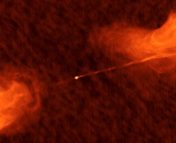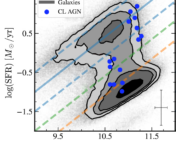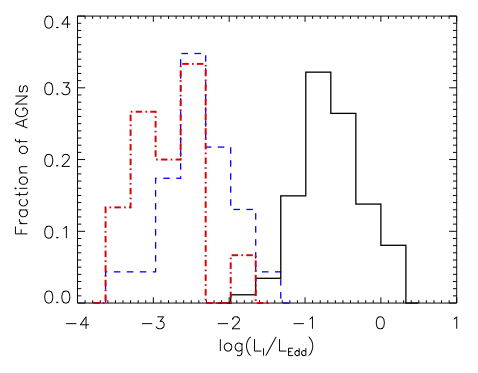Title: A radio, optical, UV and X-ray view of the enigmatic changing look Active Galactic Nucleus 1ES~1927+654 from its pre- to post-flare states
Authors: Sibasish Laha, Eileen Meyer, Agniva Roychowdhury, et al.
First Author’s Institution: NASA Goddard Space Flight Center
Status: Open access on arXiv, submitted to The Astrophysical Journal
If you’re an ambitious supermassive black hole looking to leave a mark on your host galaxy, having magnetic fields would be a good place to start. They provide a way for you to do work on your surroundings, whether it’s through launching relativistic jets, plasma bullets, violent winds, or even, a rocket exhaust. But there is a catch: you don’t have any matter making you up, so you can’t generate magnetic fields on your own. You are dependent on absorbing the magnetic flux provided by outside plasma. And there comes a point where the flux becomes so strong that your incoming accretion stream gets disrupted, interfering with your nice dinnertime. So what’s a ravenous black hole got to do? Is there a way you can take a break from this magnetic arresting of your accretion disk? Perhaps today’s paper has some information about such a thing happening…
Coming Out of My Magnetic Cage, and I’ve Been Doing Just Fine
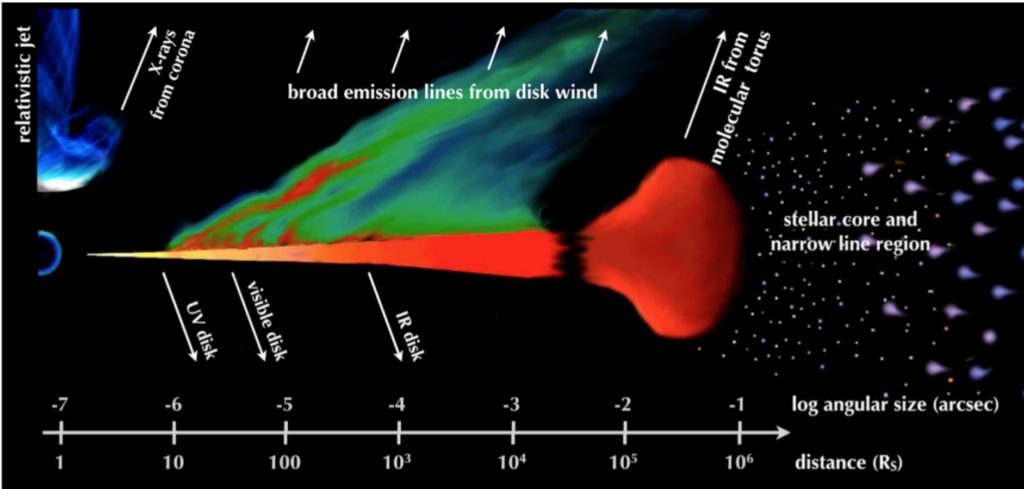
Active galactic nuclei (AGN) optical spectra are generally classed as being one of two types, Type 1 (with broad emission lines present) and Type 2 (with broad emission lines absent). The broad emission lines come from fast-moving gas that is ionized by the accretion disk’s ultraviolet light, in a place known as the broad line region (see Figure 1). Since supermassive black holes are so big, their accretion disks are thought to change output dramatically only on timescales far longer than we can observe (i.e. 100,000 years). For the most part, once an AGN is put in one of these two types, they stay in that type for the foreseeable future.
However, a minuscule minority of AGN, called changing-look AGN, are known to shift between types. Perhaps the most dramatic example is 1ES1937+654, originally classed as a Type 2 AGN. Starting in December 2017, it shifted to a Type 1 classification, brightening in the optical and UV by almost a factor of 100 and showing broad emission lines. Optical and ultraviolet light come from the accretion disk of the black hole (see Figure 1), so this suggests a dramatic increase in the disk’s luminosity. Even more strangely, in June – Aug 2018 the source practically stopped emitting X-rays. AGN X-rays come from a population of hot (billions of degrees!) electrons close to the black hole known as the corona, often hypothesized to be located at the base of the black hole’s relativistic jet (see Figure 1). This is therefore an AGN where the black hole corona disappeared, a rare event indeed. While this source has been the subject of much previous analysis, for the first time the authors of today’s paper not only analyze data taken before and during the AGN’s flare, but after the flare, when it returned to its original brightness and Type-2 spectrum.
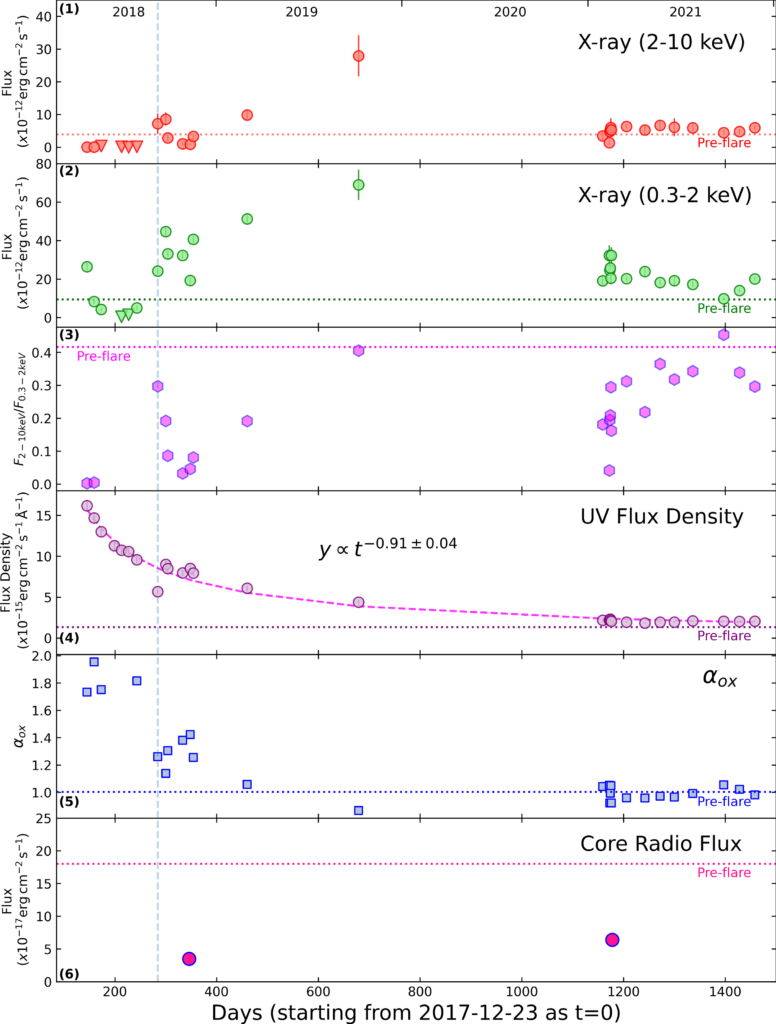
It Started Out with a Pole Flip How Did it End Up Like This?
The observations of 1ES1937+654 analyzed by today’s paper are shown as light curves in Figure 2. As can be seen in the figure, the AGN violently flared in the UV in December 2017, then dimmed over time at a rate of approximately t-0.91. The X-rays drop to a minimum in June-Aug 2018 independently of the UV before returning in October 2018. They reached their peak in November 2019 before declining to their pre-flare values. The fact that the X-rays and UV change independently of each other is very surprising, because the X-ray and UV luminosity of AGN are normally tightly correlated with each other. In contrast, the radio flux reached a minimum at the same time as the X-rays. Radio is thought to come from the relativistic jets of an AGN, so it appears the jets and the coronae at their base vanished. What could cause the disappearance of the corona and jets while also causing a brightening of the accretion disk?
Previous papers have attempted to answer this question using a tidal disruption event (TDE). But that may not be quite right because of the UV decay rate; for TDE’s it is generally t-5/3, not t-0.91. The fact the source returns to normal after the flare also suggests the process that happened cannot be due to an increase in the amount of external matter delivered to the accretion disk itself; the AGN would remain in a heightened state for more than just a few years after that. The authors postulate that what is actually going on is a magnetic pole reversal, perhaps similar to that which occurs in the Earth or the Sun.

The schematic of the process is shown in Figure 3. Originally the accretion disk near the black hole is in a magnetically arrested state: the magnetic flux threading the black hole is saturated at its maximum level, and plasma has to fight its way through the field to accrete onto the black hole. In this state the jets and corona are strong but the accretion rate is low (2011 in Figure 3). At some point, the magnetic polarity in the outer accretion disk reverses. The reversed field is carried deeper into the disk as plasma flows towards the black hole at an accelerated rate. The accretion rate rises, creating the UV/optical flare (Dec 2017 in Figure 3). The reversed field then is carried into the black hole by the inflowing plasma, and cancels out the pre-existing magnetic field on the hole. Without magnetic fields, the jets and coronae shut off (Aug 2018 in Figure 3) creating the dip in the X-rays that occurs separately from the UV flare event. Eventually enough oppositely-directed magnetic flux is absorbed by the black hole that it possesses magnetic fields again, but with the opposite polarity. The corona and jets return, as do their attendant X-rays (November 2019 in Figure 3). For a little while, the X-rays are even brighter than they were initially, because the accretion rate is still elevated. Eventually, the accretion rate declines to its previous low levels, and the AGN returns to its initial state (2021 in Figure 3).
If today’s paper’s analysis of 1ES1937+654 is anything to go by, there might be hope for supermassive black holes desperate for a magnetism-free meal. But it is only a temporary respite, and you won’t be able to smite anyone with your galaxy-wrecking beams when you do so. Oh well, c’est la vie.
Astrobite edited by Kayla Kornoelje
Featured image credit: Figure 1 from Scepi et al. 2021, Monthly Notices of the Royal Astronomical Society: Letters, 502, L25

